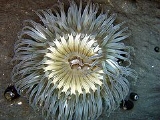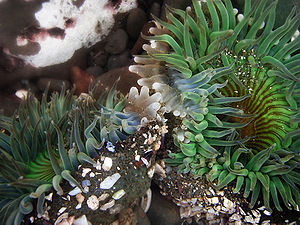
Starburst Anemone
Encyclopedia
The starburst anemone, is a species
of sea anemone
, of the family
Actiniidae
. It can be found in a low tide zone below the sea level.
The starburst anemone looks very similar to aggregating anemone
, Anthopleura elegantissima , and formerly was simply identified as a solitary form of A. elegantissima. Pearse and Francis identified it as a separate species by molecular techniques in 2000. It grows larger than Anthopleura elegantissima usually does (averaging 12cm but up to 25 cm wide),
This species of anemone reproduces sexually.
Zooxanthella
e in the gastrodermal layer. The column has numerous sticky verrucae or tubercles arranged in longitudinal rows to which gravel and shell fragments adhere. The oral disc is radially striped and has five rings of thick, pointed feeding tentacles. These vary in color and often have contrasting tips. The central mouth has large, frilly lips.
and Baja California
. It lives in the lower intertidal zone in rocky habitats, often in the shelter of cracks and crevices. When the tide is out it is often concealed by shell fragments and other particles that adhere to it.
 When the feeding tentacles of neighboring starburst anemones touch each other, they inflate their fighting tentacles (called acrorhagi) and fight each other until one moves. The white tips of acrorhagi is a concentration of stinging cells and when touching an enemy, these slough off and continue stinging the enemy again and again. The aggregating anemone (Anthopleura elegantissima) also possesses acrorhagi, which are used to fight their clone war.
When the feeding tentacles of neighboring starburst anemones touch each other, they inflate their fighting tentacles (called acrorhagi) and fight each other until one moves. The white tips of acrorhagi is a concentration of stinging cells and when touching an enemy, these slough off and continue stinging the enemy again and again. The aggregating anemone (Anthopleura elegantissima) also possesses acrorhagi, which are used to fight their clone war.
Species
In biology, a species is one of the basic units of biological classification and a taxonomic rank. A species is often defined as a group of organisms capable of interbreeding and producing fertile offspring. While in many cases this definition is adequate, more precise or differing measures are...
of sea anemone
Sea anemone
Sea anemones are a group of water-dwelling, predatory animals of the order Actiniaria; they are named after the anemone, a terrestrial flower. Sea anemones are classified in the phylum Cnidaria, class Anthozoa, subclass Zoantharia. Anthozoa often have large polyps that allow for digestion of larger...
, of the family
Family (biology)
In biological classification, family is* a taxonomic rank. Other well-known ranks are life, domain, kingdom, phylum, class, order, genus, and species, with family fitting between order and genus. As for the other well-known ranks, there is the option of an immediately lower rank, indicated by the...
Actiniidae
Actiniidae
The Actiniidae is the largest family of sea anemones, to which most common, temperate, shore species belong. Most members of this family do not participate in symbioses with fishes. One exception is the so-called bubble anemone - Entacmaea quadricolor....
. It can be found in a low tide zone below the sea level.
The starburst anemone looks very similar to aggregating anemone
Aggregating anemone
Anthopleura elegantissima, also known as the aggregating anemone or clonal anemone, is the most abundant species of sea anemone found on rocky, tide swept shores along the Pacific coast of North America. This cnidarian hosts endosymbiotic algae called zooxanthellae that contribute substantially to...
, Anthopleura elegantissima , and formerly was simply identified as a solitary form of A. elegantissima. Pearse and Francis identified it as a separate species by molecular techniques in 2000. It grows larger than Anthopleura elegantissima usually does (averaging 12cm but up to 25 cm wide),
This species of anemone reproduces sexually.
Description
The column is a pale greyish-green color and is twice as long as its width when extended. The color is partly caused by symbioticSymbiosis
Symbiosis is close and often long-term interaction between different biological species. In 1877 Bennett used the word symbiosis to describe the mutualistic relationship in lichens...
Zooxanthella
Zooxanthella
Zooxanthellae are flagellate protozoa that are golden-brown intracellular endosymbionts of various marine animals and protozoa, especially anthozoans such as the scleractinian corals and the tropical sea anemone, Aiptasia....
e in the gastrodermal layer. The column has numerous sticky verrucae or tubercles arranged in longitudinal rows to which gravel and shell fragments adhere. The oral disc is radially striped and has five rings of thick, pointed feeding tentacles. These vary in color and often have contrasting tips. The central mouth has large, frilly lips.
Distribution and habitat
The starburst anemone is found in the north east Pacific Ocean. In the United States it occurs between central CaliforniaCalifornia
California is a state located on the West Coast of the United States. It is by far the most populous U.S. state, and the third-largest by land area...
and Baja California
Baja California
Baja California officially Estado Libre y Soberano de Baja California is one of the 31 states which, with the Federal District, comprise the 32 Federal Entities of Mexico. It is both the northernmost and westernmost state of Mexico. Before becoming a state in 1953, the area was known as the North...
. It lives in the lower intertidal zone in rocky habitats, often in the shelter of cracks and crevices. When the tide is out it is often concealed by shell fragments and other particles that adhere to it.
Fight for a place


